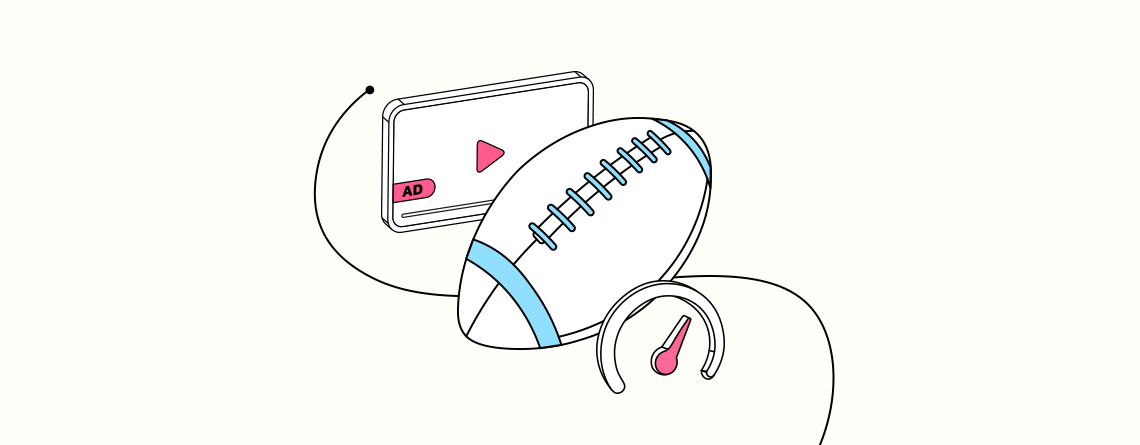To get those answers we used real-time social listening data from Infegy and crunched the data
to see how each brand was trending during the big game. We dove deeper into the sentiment and conversation themes around each spot, uncovering four key opportunities for advertisers to apply moving forward in 2024.
This year, more than a dozen brands entered the Super Bowl for the first time. Those who win are able to appeal to a broad audience, while still staying true to their core consumer and brand ethos in an authentic way.
Introduction
As the Kansas Chiefs celebrate their Super Bowl LVIII victory against the 49ers in an epically paced showdown, there is a lot to be learned from the good, bad and ugly of the big game. Nope, not that game. The one off the field… “The Ad Bowl”.
We’ve seen hundreds of Super Bowl ads over the years, and one thing remains a constant – there are always big wins and memorable fails. So, as we look ahead to the mega-year of sporting moments 2024 has in store, the big question is:
What can we learn from Super Bowl LVIII, the high and low performers, to make our strategies stronger for the big moments to come?
Analysis and Key Opportunities
To get those answers we used real-time social listening data from Infegy and crunched the data to see how each brand was trending during the big game. We dove deeper into the sentiment and conversation themes around each spot, uncovering four key opportunities for advertisers to apply moving forward in 2024.
Brainlabs Explainer
Even in big mass-reach moments, it’s critical for brands to understand their target audience and what perception they’re trying to build for their brand
High Performers of Super Bowl LVIII
Kawasaki
SCORE 8.5 Kawasaki
As a challenger brand, it was the perfect time for Kawasaki to come into the spotlight with a Super Bowl campaign and drive awareness of their new Ridge Side x Side. Not only did they hop on a hairstyle trend that was already big with their core audience and has been growing in interest with the wider population – yep, interest in mullets increased 125% over the last 5 years! – but they also used WWE’s Steve Austin, aka Stone Cold, in a way that was highly relevant for their audience and creative ambitions. And all while not taking away from the brand and product goal of gaining awareness and showing the Ridge Side x Side versatility.
Source: kawasaki.com
Temu
SCORE 2 Temu
Temu. The most talked about brand of the Super Bowl, with the least liked ad of the Super Bowl. One key misstep was treating the Super Bowl as a ‘just be there to be seen’ moment, with a basic ad concept with high frequency, that was lacking in creativity. While the brand has lower awareness, it’s also a brand that is highly untrusted. The concept for the ad did nothing to use this moment to build new memory structures and shift that perception. In fact, it increased their levels of distrust amongst people who knew them and only 18% of sentiment was positive.
But it wasn’t just creative. It’s important to note that TV ads, even in the biggest moments, are not the biggest drivers of building trust. Today, emerging channels like influencer marketing have become the driving forces of high brand trust, and it’s a place Temu could capitalise hugely if executed correctly.
Source: youtube.com
CeraVe
SCORE 9 CeraVe
Similar to what Bubly did with Michael Buble, CeraVe partnered with Michael Cera which drove >90% positive sentiment. While the name alone made the campaign work well, it was the creative execution and thoughtfulness of keeping the value of the brand – dermatology recommended – that gave the campaign its wings. Michael Cera’s recent performance in Barbie gave him more exposure as people fell in love with the humor and innocence of the character. CeraVe capitalised on this, but tied the product so tightly to its core values that he was never the only ‘star of the show’. In fact, you find out when he’s at a table of dermatologists at the end, it’s not Michael Cera who is the star at all. The ad proved that with the right alignment between brand/product x creative x celebrity you can achieve high performance.
Source: cerave.com
Michelob Ultra
SCORE 5 Michelob Ultra
If this year felt less like the Super Bowl to you and more like the Celeb Bowl, we’re not surprised. 56% of the ads shown featured a celebrity and a good portion featured multiple celebrities in one spot. But as per Kantar’s recently released findings, celebrities are not an instant ticket to effectiveness, with an average score of 2.6 stars on the scale of performance.
Celebrities can rack up attention and fame for a brand, but they can also cloud the brand’s identity if not used properly.
Even though they used some of the biggest names of the night – Messi, Marino and Sudeikis – for a 60-second spot called “Superior Beach”, it didn’t garner as much attention as the big-name ticket could have. Ending up lower on the list of brand conversation, it lacked strong brand integration and clarity on what they were trying to achieve. Was it showing it’s the best lower calorie option, trying to steal share of beach from Corona, or pitting it as the healthy choice for the superior soccer person?
The options are endless and regardless of the answer, most people will remember this spot as the Messi ad, not the Michelob Ultra ad – a sign of a concept too reliant on the celebrity.
Source: michelobultra.com
Dunkin’
SCORE 10 Dunkin’
You would think based on the performance of Dunkin’s Super Bowl campaign that they’ve been at this as long as Budweiser, but it’s only their second year here. Ranked the #2 most talked about brand (after Temu), the campaign quickly won hearts. But what made this campaign so successful wasn’t just that the ad itself was well-executed and highly talked about, but that Dunkin’ created an entire ecosystem around “DunKings” that started even before the game itself and, crucially, will live long after.
They redefined the traditional swimlanes of brand and performance to show how they can work effortlessly together by building on what’s worked in the past with additional celebrities and influencers, well-timed TikTok content, product extensions (their dunkin tracksuit sold out in 19 minutes) and strong community marketing that continues to fuel conversations and clicks post-game.
Source: youtube.com
Pringles
SCORE 6 Pringles
While Pringles used Chris Pratt to fuel the narrative around things that look like Mr. P, the Super Bowl ad was disconnected from the rest of their ‘Have You Seen Mr.P?’ campaign and Sweepstakes. It wasn’t just the fact that the ad garnered lower conversation than other CPG brands like Reese’s (who didn’t even use a celebrity in their ad), but there was also no reference or call to action to the #ISeeMrP campaign, which this ad was supposed to fuel.
Source: pringles.com
While Dunkin’ showed the importance of using your talent to extend beyond the 30-second spot with wider content creation, Chris Pratt’s content beyond the ad was limited and lower quality resulting in less buzz and engagement overall. This risks leading to a quick down-turn on the fame the brand had set out to build.
Frank’s Red Hot
SCORE 7 Frank’s Red Hot
Frank’s Red Hot didn’t do a traditional TV spot, but instead used their owned social channels to hack the Super Bowl conversation. Using Jason Kelce (brother of Travis), a likely high-trending celeb for the game, they remixed all food items that had Super Bowl ads with Jason adding Frank’s Red Hot to the dish. In doing so they created a stream of highly relevant content. This not only helped them create their own distinct conversation, but it capitalized on all conversations for other brands, adding Frank’s to those conversations as well.
This shows how owned channels and influencers can come together to drive high performance for less budget, without diluting creativity.
Source: youtube.com
Pizza Hut
SCORE 4 Pizza Hut
Pizza Hut aimed to have the best of both worlds, but the vision for their campaign didn’t feel clear. Instead of paying for an ad during the live game, Pizza Hut launched their new catchphrase “Pizza wHut” and hot honey flavor in a pre-game spot. At the same time, they launched a “Pizza wHut” inspired remix of “Turn Down for What” with Lil Jon that only garnered one million views on TikTok and 300 views on YouTube.
With their desire to make “Pizza wHut” a trend and grow awareness of the new flavor, TikTok and YouTube were the right places to be, but their reluctance to move away from a TV-spot hindered their ability to go all-in on social and resulted in lower performance. At the same time they sacrificed potential reach by focusing on pre-game.
Source: youtube.com
Key Opportunity 01: Audience Understanding & Brand Perception
Even in big mass-reach moments, it’s critical for brands to understand their target audience and what perception they’re trying to build for their brand
Takeaway
In the big moments, creative becomes even more important to driving high performance, but media principles must remain. To unlock opportunity it is critical that brands uncover audience and brand insights that will show them what they need to achieve and what is the best way to do it.
Key Opportunity 02: Effective Celebrity Usage
Celebrities can rack up attention and fame for a brand, but they can also cloud the brand’s identity if not used properly.
If this year felt less like the Super Bowl to you and more like the Celeb Bowl, we’re not surprised. 56% of the ads shown featured a celebrity and a good portion featured multiple celebrities in one spot. But as per Kantar’s recently released findings, celebrities are not an instant ticket to effectiveness, with an average score of 2.6 stars on the scale of performance.
Takeaway
Aligning your talent choices to the audience and creative are critical, but to drive high performance you also need the right mix of talent x brand / product. To find a better balance it’s important to plan brand and audience-first vs. celebrity-first to maximize impact.
Key Opportunity 03: Connected POE Ecosystems
Thoughtful connections across POE can transform a ‘singular spot’ into a meaningful campaign that drives high performance for the long term.
By now, most advertisers and agencies know the consumer experience is the most important thing to build your campaign around. To drive high performance it is important that you’re creating a connected brand and performance ecosystem across all your paid, earned and owned media that feels consistent.
Takeaway
To drive high performance in the Super Bowl it takes a mindset that recognises the shift from this event being brand awareness only, to a huge brand and performance opportunity. Ensuring your entire ecosystem is connected and traditional channels are working in unison with digital and emerging platforms will lead to a stronger consumer experience and stronger bottom-line results.
Key Opportunity 04: Beyond the TV Spot
It doesn’t take a TV-spot in the big game to breakthrough the noise and get attention and buzz that drives real results.
To drive tangible high performance, it’s not just about being ‘in’ the big game, but ensuring you are in the big game in the way that’s right for your audience, brand and budget. That might mean surrounding it in a different way, or a multitude of ways, than a 30-second TV spot.
Takeaway
To drive high performance and be creative doesn’t have to mean a 30-second ad spot. By understanding the smaller moments around and within the Super Bowl, brands can find a plethora of opportunities to align with. In a digital ecosystem it’s important to remember brands can capitalize on emerging channels and their algorithms to create valuable excitement and buzz for their brands.
Verdict
In the same way that brand and performance must work in synergy to drive high-performance results, so must an approach to big-ticket moments like the Super Bowl. These four actionable strategies work best when united to create a holistic communications system that will transcend the big moment with sustainable results long after the final whistle has blown.
For more fresh insights like this, and to find out more practical ways to drive High Performance for your brand, connect with our experts.
Insights provided by:
Katherine Cook
VP, Audience Intelligence



